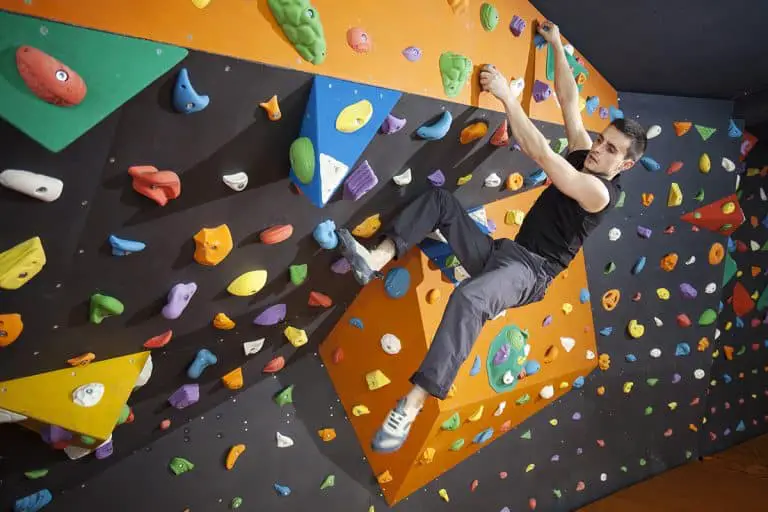Apart from this, bouldering is a very complex, dynamic, enjoyable, and social activity. Bouldering also provides a good workout, can help you lose a few pounds, and even challenge you to exceed your expectation and be your best self physically and mentally.
Is Bouldering Difficult?
Although bouldering is accessible to beginners because of the lack of equipment, bouldering is considered a hard discipline for average people. Even among the climbing community, bouldering is deemed to be a difficult sport physically and mentally.
Physically, bouldering is hard because it requires a lot of strength to carry and pull up your body on the wall using arms and legs. It also demands coordination as you make powerful moves to propel you higher depending on the problem. Additionally, you need to approach it mentally as you try to solve problems and apply moves technically.
Why Is It Called Bouldering?
The sport’s name came from the act of climbing small rock formations called boulders. Bouldering is a form of rock climbing without the use of safety ropes and harnesses.
These boulder routes called problems are climbed in short but powerful sequences which require a lot of strength and stamina.
What is the Birthplace of Bouldering?
The Fontainebleau region of France was known as a popular climbing area in the early 20th century.
It is where some of the first active and serious boulderers known as “bleausards” appeared.
Who Invented Bouldering?
Oscar Eckenstein, an English mountaineer and rock climber, was considered one of the pioneers of bouldering. Back then, in the 1800s, they climbed boulders to prepare and train for higher and harder ascents.
There are many contradicting references on how bouldering came to be. Many also believe that it only officially started in the 20th century when Pierre Allain, French climber, and inventor of climbing shoes, introduced the sport with the Bleausards in Fountainebleau.
Is Bouldering the Same as Rock Climbing?
Though often interchanged by many, bouldering and rock climbing are two separate disciplines with their own unique challenges. For starters, they involve different training, techniques, and gear and equipment.
Additionally, both sports use different muscle groups and require different mental practices of stamina and endurance.
What is the Difference Between Bouldering and Rock Climbing?
Perhaps the main difference between the two sports is the route a person climbs. Rock climbing routes are generally around 40 m to about 300m while bouldering walls or problems are only around 15 feet.
Execution-wise, rock climbing makes use of protective gear like rope, harness, helmet, quickdraws, and the like. Bouldering on the contrary, only requires climbing shoes, chalk and chalk bag, a brush, and a crash pad.
Is Bouldering Harder Than Rock Climbing?
This question rarely has to do with the sport itself but rather the climber’s strength and skill relative to the sport.
On one hand, bouldering can be hard for it relies a lot on consecutive power moves to finish a short problem. On the other hand, rock climbing demands endurance and stamina from a climber as you climb up and finish a long route.
Does Bouldering Make You a Better Climber?
The no-nonsense nature of bouldering (literally just putting on climbing shoes and going straight to it), allows you to focus on the essence of climbing without worrying about plenty of technical concepts relating to rock climbing like safety gear and equipment. In addition, it also helps improve the following:
- Consistency: As a social sport, bouldering allows people from different backgrounds to come together, cheer on each other, and give advice and beta. The camaraderie helps to keep people consistent in practice.
- Endurance: Short routes train your body to get used to the demands of a tough climb.
- Movement on the wall: Short problems make it easier for you to practice basic fundamental techniques and movement without worrying about the height and safety on the route. This allows someone to improve by repetition—fall, think of new strategies and start again.
- Stamina: As a moderately hard sport, bouldering demands a lot of stamina because it aids the power moves you execute to move through the boulders quickly. Practicing short problems conditions your muscles and prepare them for rock climbing.
- Training Stimuli: Speaking of conditioning, bouldering challenges you to outdo your current capabilities by consistent practice, drills, and challenges that whips up not only your body but also your brain, to shape.
Why is Bouldering a Key Aspect of Rock Climbing?
According to history, one of the early usages of bouldering was to prepare rock climbers for harder and higher routes. By climbing short problems, you can improve fundamental skills needed like your footwork, grips, etc. All essential to rock climbing!
Engaging in bouldering also strengthens your muscles and allows you to overcome the fear of falling. You can do better rock climbing with all these skills than a person who has never bouldered before.
Is Bouldering Better Than Top Roping?
To compare the two is to compare apples to oranges. Bouldering and top roping are both good sports in the field of climbing. In the end, it all comes down to your personal preference.
Some people may find that they enjoy top-roping better than bouldering or vice versa. Personal preference plus your comfort level will determine your inclination to a specific sport.
Is Bouldering Harder Than Top Roping?
Although bouldering is scarce in terms of equipment, it is generally harder than top-roping. It takes time to get acquainted with bouldering as it requires intense physical and mental strength at the same time. It also takes time to get the fundamentals needed to boulder.
From a more technical standpoint, comparing the bouldering V-Scale to top rope’s Yosemite Decimal System (YDS), you will find that the beginner grade in bouldering, VB, is considered a 5.9 in top-roping which is an intermediate grade.
Should I Boulder or Top Rope?
Your choice of climbing sport should depend on what your focus is. Though both are equally fun, you will find that getting into the right sport with your interests in mind will lead to a more fulfilling experience.
You should also keep in mind that each requires a different skill set. For example, bouldering focuses on technique, muscle strength, knowledge, and endurance while top-roping leans more into building stamina.
How Do You Start Outdoor Bouldering?
If you’ve been bouldering for a while in your local climbing gym and you’re anxious to try your hand at outdoor bouldering (pun intended), then read on for some tips on how to get started:
- Start slow and steady: When it comes to outdoor climbing, it’s wise to get a feel of the rocks first before you go beast mode on climbing. Be easy on yourself and know that it is okay to struggle at first and it might take a bit of time to adjust to advance through outdoor grades.
- Master spotting: Perhaps a required skill in outdoor bouldering is spotting. Learning to properly spot a person climbing will greatly reduce injuries and avoid accidents altogether. This is often overlooked in indoor settings because climbing gyms are mostly well-padded so climbers have nothing to worry about.
- Don’t be afraid to fall: In relation to spotting, falling is also essential in climbing outdoors. When it is your turn to climb, you should also learn and be conscious of falling. Take time to process and visualize how your fall might look like and prepare for it. This helps not only your spotter but also yourself!
- Check and double-check descents: When climbing through problems, it won’t hurt to survey descents once you reach the top so prevent surprises on the down-climbs.
- Mind the footwork: One common mistake beginner boulderers do is to neglect proper footwork. Though hand placement is equally important, putting some thought into footwork can improve your climbing technique drastically, especially outdoors. Try practicing easy outdoor problems so you can focus on improving footwork.
- Learn conditions and friction: A good climber is one who considers and takes advantage of the weather conditions outdoors. Do yourself a favor: read up and ask around fellow climbers about the benefits of good conditions and the science of friction and how you can use them to your advantage.
- Honor the crags: Despite the fact that bouldering doesn’t have any strict rules, there is one that everyone agrees on—honor the rock. First-time outdoor climbers should know the part they play in keeping the crags protected from damage.
- Take care of your skin: Rough outdoor rock can take a toll on your skin, especially on the hands and fingertips. Invest in a sandpaper or a pumice stone and use a moisturizer to keep your hands in tip-top shape, ready for the next outdoor adventure.
Is Bouldering Dangerous?
Like all climbing sports, bouldering poses a certain risk of injury. This is due to the fact that there is no equipment needed to boulder, just bouldering shoes, chalk, and yourself.
However, the most common issues can be prevented when you have gone through proper bouldering training. Research also shows that common injuries are usually minor and includes the following:
- Climber’s knee
- Pulled tendons in the hands and fingers
- Sprained ankles
- Sprained wrists
- Tennis elbow (climber’s elbow)
How Dangerous is Indoor Bouldering?
Indoor bouldering is a lot less dangerous than outdoor bouldering. For one, conditions in the bouldering gym are regulated compared to outdoor bouldering which can change in a matter of minutes.
Gyms also have designated crash/landing areas when you can safely fall and not worry about your crash pad sliding off the rocks like in outdoor bouldering.
How Do You Fall Safely Off a Bouldering Wall?
Proper falling is also a skill. Falling to the ground feet and then tucking and rolling is the correct method to avoid injuries. One common mistake boulderers make is to focus the impact of the fall on the knee joints resulting in a lot of pain.
Follow the steps below for a proper landing:
- Focus on your landing, make sure the area is clear.
- Adjust your stance, ensure your feet are shoulder-width apart
- Bring your arms to the chest and tuck in your head in your body
- Don’t second guess the jump
- Upon impact on the crash pad, go straight to bending your knees to avoid joint pain
- Tuck and roll to your back and side
How Do I Get Over My Fear of Falling in Bouldering?
The best and fastest way to overcome a fear of falling is to experience it again and again. Avoiding it altogether is not beneficial as falling is an essential part of climbing.
Learning how falling feels makes you feel more and more comfortable and in time the idea of falling is not going to be as daunting. If you’re just a beginner, take baby steps and climb lower and easier problems and fall.
Is Indoor Bouldering Hard?
Climbing is a challenging sport in general but between indoor and outdoor bouldering, it is easier to climb indoors. One of the reasons for this is that the environment is regulated indoors.
It is safe to say that both indoor and outdoor bouldering will challenge you physically (muscles will hurt and fingers, forearms, and legs will fatigue) and mentally (you need stamina and endurance on top of problem-solving).
Are Competition Boulders Hard?
Competitional bouldering problems range from V9 to V12 or in Font Scale 7c to 8a+. Other competitions can be easier as V6 (7a in Font Scale).
Competitions are very difficult and demanding and climbers are expected to finish four problems in around four minutes with just 15 minutes of rest in between.
Why is Bouldering So Expensive?
Since bouldering as a sport is pretty scarce in equipment, the bulk of expense goes towards climbing fees both indoor and outdoor. Gyms charge for use of facilities and some training equipment to improve technique.
Equipment and other costs are fairly affordable since they only consist of shoes (if you don’t like to rent), chalk, chalk bags, and crash pads.
What Age Can You Start Bouldering?
Children aged 4 to 7 years old can start bouldering. Around this age, they already have a sense of instruction and at the same time, they can be independent during play.
Of course, children still have to be supervised throughout the session.
Is Bouldering an Extreme Sport?
While climbing is considered an extreme sport, all of the same physical attributes of conventional sports are still necessary.
The variables that make it so successful, however, are the distinct challenges, excitement, and adrenaline rush a person feels during a session.




